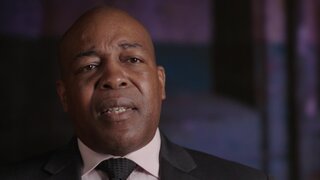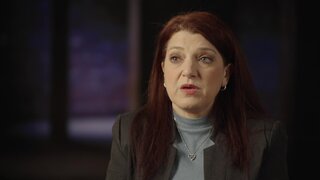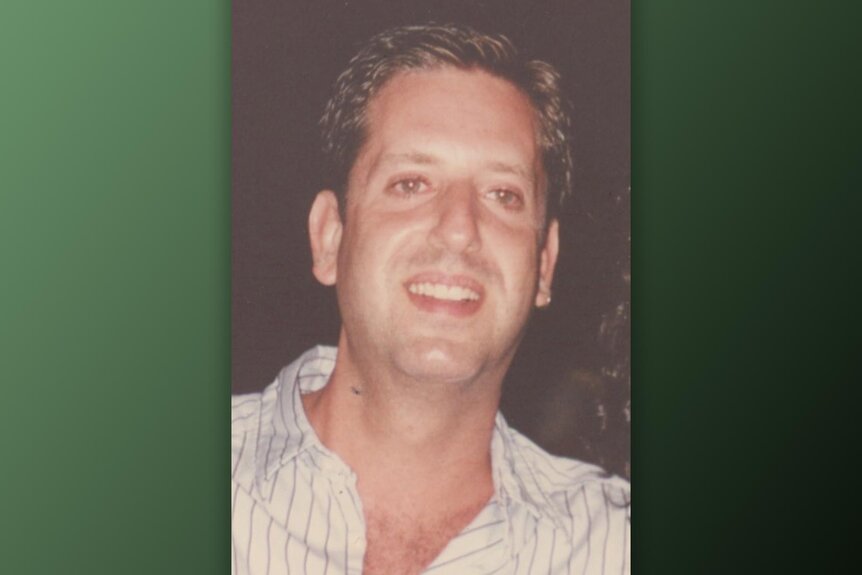Create a free profile to get unlimited access to exclusive videos, breaking news, sweepstakes, and more!
Police Investigate the 1997 Torture and Murder of Beloved Bronx Schoolteacher
Investigators wondered if the motive behind Jonathan Levin's homicide was connected to the victim's incredibly wealthy father, until a message left on an answering machine led them closer to the truth.
The 1997 murder of 31-year-old Jonathan Levin shocked many, especially since his role as a popular high school teacher touched many lives. Detectives with the N.Y.P.D. were tasked with solving his brutal murder, though several leads — including a potential romantic rival and having a tremendously wealthy father — would steer them away from the sinister truth.
Levin was a beloved English teacher at William H. Taft High School in the South Bronx, a role model to countless students, many of whom came from some of the rougher parts of New York City.
“Jonathan loved what he was doing,” fellow teacher and friend David Tantleff told New York Homicide, airing Saturdays at 9/8c on Oxygen. “He was very dedicated; he wanted to make a difference in the lives of his students.”
On Saturday, May 31, 1997, Levin never showed up for a planned school workshop meeting, according to teacher Cleo Tejada, who was once romantically involved with the victim. Concerns grew even more when, that Monday, Levin never arrived for class.
RELATED: Was a Woman Behind Her Husband's 2000 Disappearance Once Believed to be Russian Mob Hit?
Jonathan Levin found dead in Columbus Avenue apartment
Tejada and a colleague visited Levin’s Columbus Avenue apartment on the Upper West Side at around 8 p.m., enlisting the help of neighbor Richard Veloso.
“I couldn’t get in, but I’ll never forget the scent coming through his door,” said Tejada. “So, I started crying right away, and that’s when my colleague called 9-1-1.”
Uniformed officers spoke with Veloso, who had a key to Levin’s apartment since he occasionally walked Levin’s dog when Levin worked late. Veloso also described the “putrid” smell when he and the others entered Levin’s “totally dark” apartment.
Soon, they found Levin’s partially decomposed body on the kitchen floor.
“It was just a mess,” said Detective Thomas McKenna of the N.Y.P.D.’s Manhattan North Homicide. “Drawers were open. Stuff was on the floor. And then I saw the body, and we observed a lot of blood.”
Detectives quickly deduced that Levin died from a gunshot wound to the head, though he also sustained superficial slash wounds to the neck and chest, as well as multiple stab wounds. It appeared Levin was duct-taped to a chair as part of a robbery since police found the victim’s wallet missing a bank card.
No signs of forced entry suggested that Levin knew his assailant or assailants.
The public learns of Levin’s high-profile father
Gary Anthony Ramsay, then working as a news reporter for Time Warner’s NY1, covered the story that brought media attention to the Upper West Side. He was among many to soon learn that Levin’s father was then-media-mogul and Time Warner C.E.O. Gerald Levin, something Levin mostly kept hidden from others.
Despite having a wealthy father, the victim lived humbly in the Columbus Avenue apartment, though several high-profile individuals attended his funeral, including Ted Turner and actress Jane Fonda. Levin’s students, who were especially moved by Levin’s death, created a march in his honor.
“It was a lot of emotion,” Ramsay told New York Homicide. “These kids knew him. You could tell that they cared about him. He was making a difference in their life.”
RELATED: Missing Brooklyn Boxer Found 4 Years Later Buried In New Jersey With a Broken Neck
Due to Levin’s high-profile connections, detectives felt the pressure of having to solve the case. At first, they turned to Levin’s girlfriend, Cleo Tejada, who revealed that since 1996, she and Levin had a loving relationship, including tropical vacations to the Dominican Republic, getting to know Tejada’s family, and casually discussing marriage.
Tejada and her ex-husband had been separated for three years, though Tejada said her “jealous” ex confronted Levin about one month before the murder. Tejada didn’t peg her ex as someone capable of violence, and prosecutors, such as Assistant District Attorney Doug Nadjari for the Brooklyn D.A.’s Office, discovered the ex was with another woman at the time of Levin’s homicide.
“He didn’t appear to be a likely suspect,” Nadjari told New York Homicide.
A Message on the Victim’s Answering Machine
At the Columbus Avenue crime scene, detectives sifted through messages left on Levin’s answering machine.
“A lot of the messages were from concerned friends who didn’t know where he was,” said Ramsay. “But one of those messages, right around the time he was last seen alive, was different.”
The Friday, May 30, 1997, call came from someone named Corey, who said he had something “really, really, really important” to tell Levin, according to Det. McKenna. The person sounded young, and so investigators looked to Levin’s students.
Friends and neighbors said Levin could be overly open with the minors, sometimes giving out his phone number, address, or money — his way of building bonds with students in need of kindness. Levin had even planned to bring some of his students to a New York Yankees game.
“He kept on giving, kept on giving,” said Veloso. “That was his nature.”

While no students named Corey were enrolled at William H. Taft High School at the time, detectives found one of Levin’s former students from the 1993-1994 school year was Corey Arthur, described by Tantleff as a “rough and tough kid.”
Levin personally encouraged Arthur to home in on his writing skills, incorporating poetry and rap music as a means to keep clear of the rough streets. Arthur, who came from the housing projects of Brooklyn’s Bedford-Stuyvesant, already had seen his fair of trouble. With one felony conviction under his belt, Arthur was moved to a military-style school in upstate New York but still kept in close contact with Levin.
“Many just considered him a lost cause, but not Jonathan,” A.D.A. Nadjari told New York Homicide.
Police believed Levin’s openness with his students might have had something to do with his murder.
“Jonathan had his students write biographies of themselves, basically how they would describe their lives,” said Ramsay. “As part of that process, he submitted his own.”
By then, Arthur was already out of the high school, though word got back to him about one month before Levin’s murder that Levin was the son of Time Warner C.E.O. Gerald Levin.
Two suspects come to light
Police learned Corey Arthur left the message on Levin’s answering machine from a payphone between West Central Park and Columbus Avenue. Though no fingerprints could be lifted from the payphone, Arthur’s fingerprints would match one found inside the duct tape used to bind Levin to a chair on the night he was killed.
But when detectives looked for Arthur in Bed-Stuy, he was nowhere to be found.
Meanwhile, investigators sifted through Levin’s bank records, showing that on Friday, May 30, 1997 — around the time it was believed Levin died — someone used his stolen bank card to withdraw the maximum $800 from a nearby A.T.M. just minutes after Arthur left his message.
RELATED: The Shocking Reason Why Two NYC Men Committed “Haunting” 2001 Double Murder
To detectives’ surprise, grainy surveillance video didn’t show Arthur, who was about 5 feet, 11 inches tall and weighed 200 pounds, but rather a short and stocky man who didn’t match Arthur’s description.
Police now had a second, unidentified suspect on their radar and hoped a public appeal and a reward would help drum up any leads.
“They receive this anonymous tip that Corey Arthur had confessed to getting into some drama with somebody named Monty, and give them a name: Montoun Hart,” A.D.A. Nadjari told New York Homicide.
On June 7, 1997, police found Hart at his home before he voluntarily went with detectives to the precinct for questioning.
Contradicting confessions and arrests
Hart claimed the robbery was Arthur’s idea because Arthur said Levin “had access to crazy money,” according to Nadjari. Hart admitted he helped tape Levin to the chair while Arthur demanded the victim’s bank card.
Hart said Arthur had him use Levin’s card to withdraw cash from the A.T.M. and that after he returned, Arthur fatally shot Levin. It was enough for detectives to hold Hart on robbery charges, but still, they had to find Arthur.
Investigators tracked down Arthur’s girlfriend, who ultimately admitted that Arthur confessed to the murder and was hiding out at Bed-Stuy’s Sumner housing projects. That’s where police found their prime suspect, possibly before he could flee again.
“Corey Arthur’s girlfriend also indicated that they should probably act quickly because he was making plans to flee to North Carolina,” according to A.D.A. Nadjari.
Arthur’s statements to police contradicted Hart’s, with Arthur claiming he went to Levin’s house because he and Levin allegedly smoked crack cocaine. Investigators were incredulous, however, since Levin’s postmortem toxicology report showed no trace of drugs, and Arthur also made no mention of Montoun Hart.
Furthermore, Arthur claimed two strangers forced themselves into Levin’s apartment and made Arthur bind the victim, accounting for why his fingerprints were on the duct tape. He said it was for this very reason that he didn’t alert authorities after allegedly escaping the intruders, leaving Levin behind.
“The only inference we could draw from that is that Corey’s a liar,” said Nadjari.
Arthur and Hart were arrested on murder and robbery charges.
A conviction and an acquittal
On November 11, 1998, Arthur was found guilty of second-degree murder, a conviction largely built on the girlfriend’s incriminating statements and the fingerprints found on the duct tape. He was handed the maximum sentence of 25 years to life behind bars.
Prosecutors had more of an uphill battle with Hart, then charged with second-degree murder.
“The police, they didn’t have his prints in the apartment,” Ramsay told New York Homicide. “They didn’t have anybody, including Corey Arthur, implicating that he was the one who did it. So, the confession was the foundation of the prosecution’s case and the only evidence they have.”
On February 11, 1999, Hart was found not guilty of all charges.
Colleagues, like David Tantleff, were “outraged” by the decision, though friends and loved ones continued to honor Levin’s memory. Following his death, the New York Yankees played a tribute game for Levin with about a thousand William H. Taft students in attendance.
A street in front of the school was also named in Levin’s honor.
“His legacy is the students who have graduated and went forward in their life and that he had something to do with that,” said friend Richard Veloso. “I’d like to think that his students will take him forward.”
Watch all-new episodes of New York Homicide on Oxygen.



































